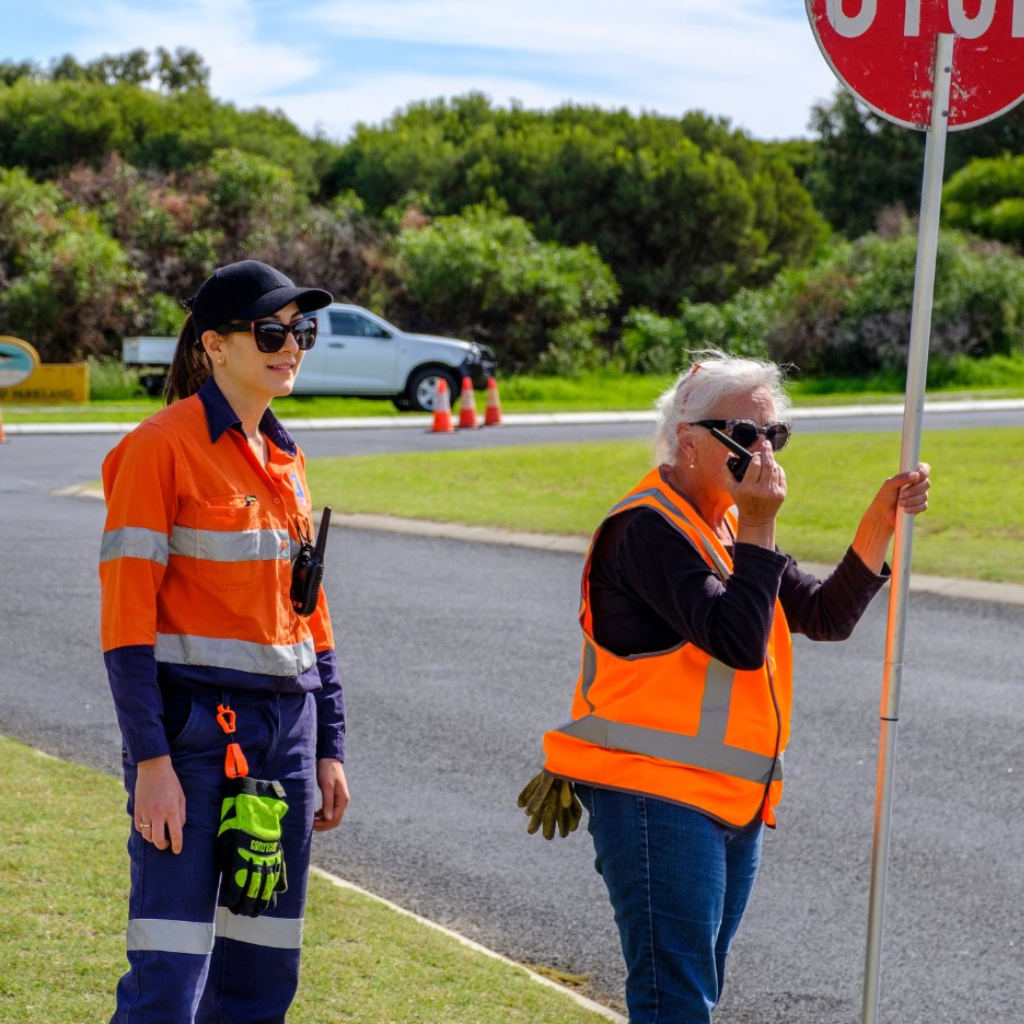7 Most Common TMP Design Mistakes
AusQ Training uncover the 7 Most Common TMP Design Mistakes & How To Avoid Them
Traffic Management Plans (TMPs) provide roadworks sites with a means of planning and implementing how road users will be affected for the duration of the temporary traffic management works.
This includes items such as safely and effectively guiding them through or past a roadwork site, as well as ensuring network performance is not unduly impacted. It is a requirement for anyone undertaking work on near a road to prepare a TMP which provides adequate safety for works and road users. However, we continue to see TMPs that are designed with mistakes or that do not comply with all legislation.
1. Inadequate Risk Assessments
Management of risk control is central to a compliant Traffic Management Plan. This involves the identification and analysis of all risks likely to arise during works on roads including during the setting up, operating, changing and ultimate dismantling of traffic guidance schemes, followed by the determination of appropriate measures to mitigate those risks. The process is applicable at all levels of planning and operation.
We commonly see TMPs with risk assessments missing justification for TMP design and not adequately addressing;
- Why is the temporary speed at 40kph?
- Why are after-hours controls needed?
- What is the risk to the public?
- Do other setup measures need to be documented to ensure the workers setup in a safe manner e.g. eliminate workers on foot crossing the freeway or highway.
Traffic Management Planners can’t just assume the speed reduction is enough and it will mitigate the risk. Motorist non-compliance is inevitable so what other controls are being put in place?
When structuring a risk assessment TMP designers need to consider.
- Who or what involved
- What hazard is identified
- What could cause this to occur?
- What is the event that will occur?
2. Lack of Project and Scope Information
Too often communication that occurs between the Project Owner and the Traffic Planner is second-hand and often lacking. We regularly see Traffic Planners provided information at short notice, missing key details, not involved in site or project meetings and in general not provided updates that will be essential to designing an effective TMP.
When there are insufficient details provided about the project scope it can create many problems, such as missing or inadequate Traffic Guidance Schemes (TGSs) for the work activity, unclear implementation instructions for the traffic crew, poor risk assessment missing elements exposing workers to further risk, delays to obtaining TMP approvals and more.
How do you improve this?
- Organise the Traffic Planner to meet up with the Project Manager on-site to view and discuss the project. This ensures everyone has a clear understanding (and details are not second hand). By doing this it removes a lot of unnecessary second guessing
- Ensure the TMP designer has obtained and understood the scope and any specifications. Clearly show and outline each work stage to ensure there is temporary traffic management that matches each stage needs
- Increase ALL communication, get involved – consider stakeholder reviews before, during and after the TMP design process.
“Good communication is the bridge between confusion and clarity” ~ Nat Turner
3. Poor Record Keeping
When there is a poorly designed TMP, it creates safety concerns and non-conformances. In addition, it also creates unnecessary work on-site for the traffic crew, with the reactive need to request onsite amendments by a Worksite Traffic Management (WTM) or Advanced Worksite Traffic Management (AWTM) accredited person. When changes on-site are required, often these amendments are not clearly documented or formally approved.
Any changes to traffic control device placements shall be recorded in the TMP;
- Traffic Guidance Scheme/s – show what signs or devices are changed
- Risk Assessment – document what risks are involved, risk rating and control measures required
- Daily Diary – including details of who is involved and the WTM or AWTM accredited person approving the amendment
This MUST include the name and WTM or AWTM accreditation number of the person who approved the amendment. It is also important to note that the persons arranging the traffic management works shall keep their own daily records together with any other relevant records.
4. Roles and Responsibilities
It’s the age old saying with this mistake:
- Who?
- What?
- Where?
- When?
- How?
People’s roles and responsibilities need to be clearly defined within the Traffic Management Plan. Within your TMP, if it states a requirement such as an on-site audit at implementation is required, who is the person responsible for organising or completing this? Is this person/s identified at TMP design stage, is this requirement communicated to those involved and organised in advance?
This information needs to be included within the Traffic Management Plan.
5. Traffic Management Plan Roadworks Template
As stated in Main Roads WA Code of Practice for Works on Roads
4.2.1 General
Any party undertaking work on a road shall prepare a Traffic Management Plan (TMP) that adequately provides for the safety of workers and road users while maintaining an adequate level of service to road users. Traffic management planning should be undertaken in accordance with the AGTTM Part 2: Traffic Management Planning.
To ensure a consistent approach is taken when developing a TMP one of the Main Roads TMP templates [see here] shall be used as a basis for the development of the plan. Any section headings that are not applicable to the TMP being developed shall be kept in the document and noted as not applicable (with the intent of keeping the TMP section numbers
the same throughout all TMPs).
Tip: Consider adding in extra graphical detail into the written TMP to assist with interpretation, this can include:
- Site Photos
- Google Maps
- Nearmaps
- Site Drawings
- Bus Routes
You are allowed to expand on sections where you think it is needed and include additional appendixes.
6. Generic vs Site Specific TMP (how to determine which one to select)
Determining which TMP is needed for the works being undertaken is crucial. How to you determine if a Generic or Site Specific TMP is needed?
Main Roads WA have cut out the hard work and questions here by providing a checklist that will determine what type of Traffic Management Plan is required.
The amount of details and information to be provided in a TMP can vary depending upon the nature and complexity of the project. For routine/repetitive type works such as minor pavement maintenance, a generic TMP may be appropriate. The below checklist has been developed to assist in determining the need for the traffic management setup to be generic or site specific. However, those implementing the plan need to be very aware of the scope of situations covered by the plan.
When using this checklist, and answering ‘Yes’ to any of these questions requires a Site Specific plan.
Where a TMP is to be used on more than one occasion or at a number of generic locations, continuous improvement must be considered. This will ensure the quality of traffic management is maintained or improved where required.
7. Site Inspections NOT Done!
All too often, this step is MISSED.
The Advanced Worksite Traffic Management (AWTM) person preparing a TMP shall also include a statement on the plan confirming that a site visit was undertaken by him/her or another experienced person under his/her direction, prior to preparing the plan.
For Generic TMPs, a site visit by the AWTM that prepared the TMP is not required, however, the person responsible for implementing the TMP shall ensure it is applicable for the site and shall complete the generic/site specific TMP checklist (this step is crucial and not to be overlooked).
Where the generic TMP is not suitable a site specific TMP shall be developed.
Tips and Best Practice
- Physically visit the site and take photos and videos as evidence
- Complete the Main Roads WA Generic / Site Specific TMP Checklist (as a minimum)
- Check your workplace resources! Many Traffic Management companies have a simple site inspection form with prompts for the site inspection and factors to consider (including but not limited to pedestrians, public transport, site distance etc)
- Complete a risk assessment to justify the suitability of the TMP and the specific Traffic Guidance Schemes (TGS) selected
And last but not least… remember record keeping.
“Good records can save considerable investigation resources, and assist in deciding the most appropriate response to a claim”
Did you know – Main Roads WA recommends that traffic management records be securely stored for a period of not less than seven (7) years from the date of completion of the works
Tools and Template Links
- Traffic Management for Works on Roads Code of Practice
- Traffic Management for Events Code of Practice
- Traffic Management Plan (TMP) Template
- Event Traffic Management Plan (TMP) Template
- Checklist to Determine the Need for Generic or Site Specific TMP
- Example Onsite Traffic Guidance Scheme (TGS) Selection Checklist
- Traffic Management Daily Diary Template
- Event on Roads Daily Diary Template
Upskilling Opportunities
Are you looking at upskilling yourself or your team to become a qualified Traffic Management Planner OR Traffic Management Designer?
AusQ Training offer a range of courses to assist you in upskilling – to view our range of public training courses [click here] or view our calendar here.
Make a time to chat to one of our Customer Support Team members [here] to discuss your training pathway options.



